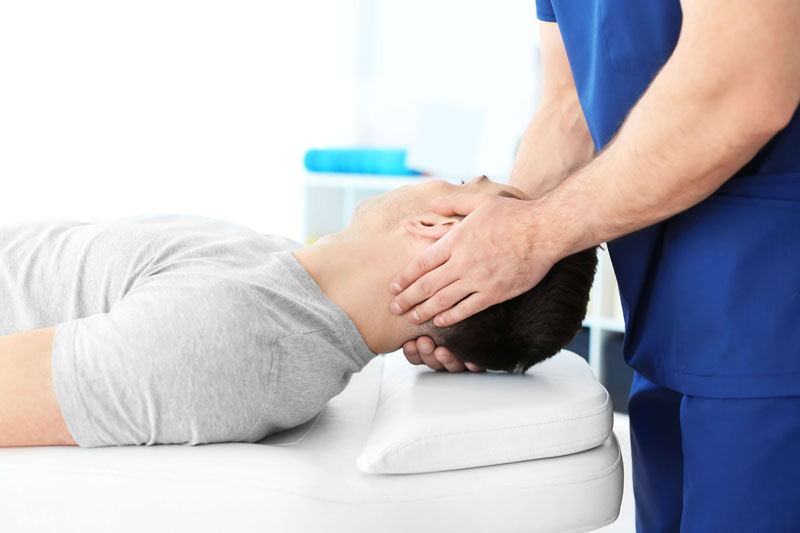In cases of cervical disc nerve compression, traction treatment is a recommended approach to proper spinal adjustment and pain relief. Traction treatment enables a chiropractor to relieve the stress/pressure that can lead to spinal disc problems like:
- Disc herniation
- Disc Rupture
- Displacement
Traction concepts differ with chiropractors. They could utilize static positioning and inversion therapy but each has there own treatment application.

Manual and mechanical cervical traction
The methodologies/techniques are different, but the results are the same. Which is used depends on an individual case basis and the chiropractic treatment plan. Injury Medical Chiropractic and Functional Medicine Clinic utilize both mechanical and manual traction approaches. Choosing the right traction treatment is based on an understanding of each technique's strengths, depending on each individual's case.

Traction approach
The difference between mechanical and manual traction is simple. Mechanical traction is aided and directed with the use of machines, weights, and pulleys while manual traction is performed by a chiropractor. Mechanical traction cradles the individual's head in a sling, which is positioned at the optimal position to get the most benefits from the adjustment. The sling is counterweighted to hold the head and neck in a specific position, leveraging mechanical pressure to generate positive cervical adjustments. Manual traction involves an individual lying down on a table, with the chiropractor adjusting/pulling the head and neck to decompress the cervical spine. The adjustment can be a continuous pull, or a series of low-velocity pulls in different directions. This depends on the individual's condition and treatment adjustment plan.

Methodology comparison
The objective of mechanical and manual traction is similar, but both are tools that a chiropractor can utilize for different benefits. Mechanical traction therapy is hands-free decompression that allows a chiropractor the time they need to work on complex cases. This method is often implemented for severe cases, where a traction session can last for 20-30 minutes. It is also helpful when educating patients on proper posture. Manual traction is controlled by a chiropractor, as they manually increase or decrease the countering force. The hands-on technique enables a chiropractor to feel the status of the cervical spine in real-time. This helps the patient understand the effects of their traction treatment.
The right technique for the individual
Traction’s overall ability to decompress the spine makes it a beneficial approach to treating a number of spinal conditions. The cause of the condition/injury and the individual's overall health can determine which approach will benefit the most. Mechanical and manual traction are just two adjustment methods/techniques. However, both forms on their own are not the only option. Both can be used in combination. Injury Medical Chiropractic Clinic is committed to developing the best approach for spinal correction for every patient.
Body Composition
Phase angle cellular health assessment for surgical risks and outcomes
Phase angle measures how the cells respond to the electrical currents used to measure body composition. It reflects the cell membrane integrity. When the body's cells are healthy, they are able to resist the InBody current, which results in a higher phase angle.
Nutritional status cardiac patient monitoring
Phase angle shows changes in cellular health that happen before the onset of cardiac cachexia or circulation issues. Monitoring these changes is used to track cardiac patient's status and can help determine surgical risks and outcomes. By assessing these results over time, a patient’s nutritional status can be monitored as they go through their rehabilitation program. Complications associated with surgery can be prevented.
Disclaimer
The information herein is not intended to replace a one-on-one relationship with a qualified health care professional, licensed physician, and is not medical advice. We encourage you to make your own health care decisions based on your research and partnership with a qualified health care professional. Our information scope is limited to chiropractic, musculoskeletal, physical medicines, wellness, sensitive health issues, functional medicine articles, topics, and discussions. We provide and present clinical collaboration with specialists from a wide array of disciplines. Each specialist is governed by their professional scope of practice and their jurisdiction of licensure. We use functional health & wellness protocols to treat and support care for the musculoskeletal system’s injuries or disorders. Our videos, posts, topics, subjects, and insights cover clinical matters, issues, and topics that relate to and support, directly or indirectly, our clinical scope of practice.* Our office has made a reasonable attempt to provide supportive citations and has identified the relevant research study or studies supporting our posts. We provide copies of supporting research studies available to regulatory boards and the public upon request. We understand that we cover matters that require an additional explanation of how it may assist in a particular care plan or treatment protocol; therefore, to further discuss the subject matter above, please feel free to ask Dr. Alex Jimenez or contact us at 915-850-0900.
Dr. Alex Jimenez DC, MSACP, CCST, IFMCP, CIFM, CTG*
email: coach@elpasofunctionalmedicine.com
phone: 915-850-0900
Licensed in Texas & New Mexico
References
Madson, Timothy J, and John H Hollman. “Cervical Traction for Managing Neck Pain: A Survey of Physical Therapists in the United States.” The Journal of orthopedic and sports physical therapy vol. 47,3 (2017): 200-208. doi:10.2519/jospt.2017.6914
Wang, Kuan et al. “Cervical traction therapy with and without neck support: A finite element analysis.” Musculoskeletal Science & practice vol. 28 (2017): 1-9. doi:10.1016/j.msksp.2017.01.005
Bryans, Roland et al. “Evidence-based guidelines for the chiropractic treatment of adults with neck pain.” Journal of manipulative and physiological therapeutics vol. 37,1 (2014): 42-63. doi:10.1016/j.jmpt.2013.08.010




